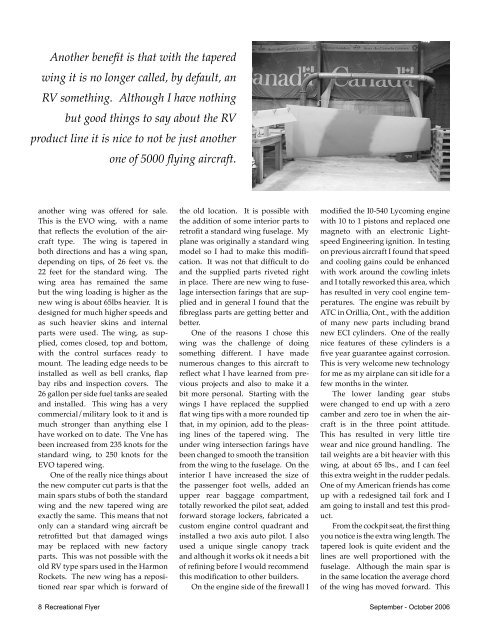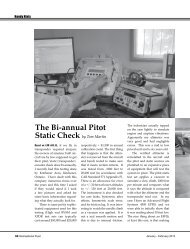September - October - The Recreational Aircraft Association
September - October - The Recreational Aircraft Association
September - October - The Recreational Aircraft Association
Create successful ePaper yourself
Turn your PDF publications into a flip-book with our unique Google optimized e-Paper software.
Another benefit is that with the tapered<br />
wing it is no longer called, by default, an<br />
RV something. Although I have nothing<br />
but good things to say about the RV<br />
product line it is nice to not be just another<br />
another wing was offered for sale.<br />
This is the EVO wing, with a name<br />
that reflects the evolution of the aircraft<br />
type. <strong>The</strong> wing is tapered in<br />
both directions and has a wing span,<br />
depending on tips, of 26 feet vs. the<br />
22 feet for the standard wing. <strong>The</strong><br />
wing area has remained the same<br />
but the wing loading is higher as the<br />
new wing is about 65lbs heavier. It is<br />
designed for much higher speeds and<br />
as such heavier skins and internal<br />
parts were used. <strong>The</strong> wing, as supplied,<br />
comes closed, top and bottom,<br />
with the control surfaces ready to<br />
mount. <strong>The</strong> leading edge needs to be<br />
installed as well as bell cranks, flap<br />
bay ribs and inspection covers. <strong>The</strong><br />
26 gallon per side fuel tanks are sealed<br />
and installed. This wing has a very<br />
commercial/military look to it and is<br />
much stronger than anything else I<br />
have worked on to date. <strong>The</strong> Vne has<br />
been increased from 235 knots for the<br />
standard wing, to 250 knots for the<br />
EVO tapered wing.<br />
One of the really nice things about<br />
the new computer cut parts is that the<br />
main spars stubs of both the standard<br />
wing and the new tapered wing are<br />
exactly the same. This means that not<br />
only can a standard wing aircraft be<br />
retrofitted but that damaged wings<br />
may be replaced with new factory<br />
parts. This was not possible with the<br />
old RV type spars used in the Harmon<br />
Rockets. <strong>The</strong> new wing has a repositioned<br />
rear spar which is forward of<br />
one of 5000 flying aircraft.<br />
the old location. It is possible with<br />
the addition of some interior parts to<br />
retrofit a standard wing fuselage. My<br />
plane was originally a standard wing<br />
model so I had to make this modification.<br />
It was not that difficult to do<br />
and the supplied parts riveted right<br />
in place. <strong>The</strong>re are new wing to fuselage<br />
intersection farings that are supplied<br />
and in general I found that the<br />
fibreglass parts are getting better and<br />
better.<br />
One of the reasons I chose this<br />
wing was the challenge of doing<br />
something different. I have made<br />
numerous changes to this aircraft to<br />
reflect what I have learned from previous<br />
projects and also to make it a<br />
bit more personal. Starting with the<br />
wings I have replaced the supplied<br />
flat wing tips with a more rounded tip<br />
that, in my opinion, add to the pleasing<br />
lines of the tapered wing. <strong>The</strong><br />
under wing intersection farings have<br />
been changed to smooth the transition<br />
from the wing to the fuselage. On the<br />
interior I have increased the size of<br />
the passenger foot wells, added an<br />
upper rear baggage compartment,<br />
totally reworked the pilot seat, added<br />
forward storage lockers, fabricated a<br />
custom engine control quadrant and<br />
installed a two axis auto pilot. I also<br />
used a unique single canopy track<br />
and although it works ok it needs a bit<br />
of refining before I would recommend<br />
this modification to other builders.<br />
On the engine side of the firewall I<br />
modified the I0-540 Lycoming engine<br />
with 10 to 1 pistons and replaced one<br />
magneto with an electronic Lightspeed<br />
Engineering ignition. In testing<br />
on previous aircraft I found that speed<br />
and cooling gains could be enhanced<br />
with work around the cowling inlets<br />
and I totally reworked this area, which<br />
has resulted in very cool engine temperatures.<br />
<strong>The</strong> engine was rebuilt by<br />
ATC in Orillia, Ont., with the addition<br />
of many new parts including brand<br />
new ECI cylinders. One of the really<br />
nice features of these cylinders is a<br />
five year guarantee against corrosion.<br />
This is very welcome new technology<br />
for me as my airplane can sit idle for a<br />
few months in the winter.<br />
<strong>The</strong> lower landing gear stubs<br />
were changed to end up with a zero<br />
camber and zero toe in when the aircraft<br />
is in the three point attitude.<br />
This has resulted in very little tire<br />
wear and nice ground handling. <strong>The</strong><br />
tail weights are a bit heavier with this<br />
wing, at about 65 lbs., and I can feel<br />
this extra weight in the rudder pedals.<br />
One of my American friends has come<br />
up with a redesigned tail fork and I<br />
am going to install and test this product.<br />
From the cockpit seat, the first thing<br />
you notice is the extra wing length. <strong>The</strong><br />
tapered look is quite evident and the<br />
lines are well proportioned with the<br />
fuselage. Although the main spar is<br />
in the same location the average chord<br />
of the wing has moved forward. This<br />
8 <strong>Recreational</strong> Flyer <strong>September</strong> - <strong>October</strong> 2006




